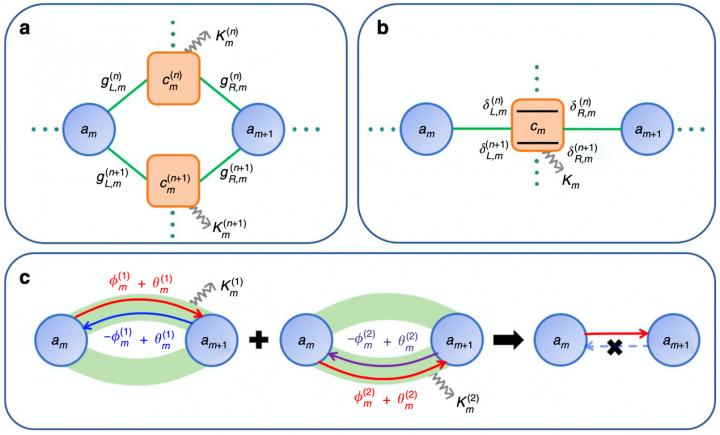
Credit: by Xinyao Huang, Cuicui Lu, Chao Liang, Honggeng Tao, and Yong-Chun Liu
Optical nonreciprocity, which prohibits the light field returning along the original path after passing through the optical system in one direction, is not only of vast interest to fundamental science, which brings us a deeper understanding of Lorentz reciprocity, time-reversal symmetry, and topological effects, but is also of great importance for realizing nonreciprocal optical and electromagnetics devices such as isolators, circulator and directional amplifiers, which are indispensable for applications ranging from optical communication to optical information processing.
However, realizing nonreciprocity is rather difficult as it requires breaking of the Lorentz reciprocity theorem. In other words, the protocols to nonreciprocity generation are limited as a result of the time-reversal symmetry and linear property of Maxwell’s equations. Most of the existing approaches to realize nonreciprocity can be grouped into three categories with the following requirements: (i) magnetic field induced breaking of time-reversal asymmetry, (ii) spatiotemporal modulation of system permittivity; (iii) nonlinearity. Nevertheless, these principles either meets difficulties for integration, or requires stringent experimental conditions, or has limited performances.
In a new paper published in Light Science & Application, a team of scientists, led by Professor Yong-Chun Liu from State Key Laboratory of Low-Dimensional Quantum Physics, Department of Physics, Tsinghua University, China, and co-workers have proposed a new principle to realize nonreciprocity by going beyond the existing three categories of approaches. The idea is using energy loss to induce nonreciprocity. The loss in a resonance mode induces a phase lag, which is independent of the energy transmission direction. By combining multichannel lossy resonance modes, the interference gives rise to nonreciprocity, with different coupling strength for forward and backward directions [Fig. 1].
For the completely nonreciprocal points, i.e., the coupling only exists in one direction, the eigenvalues of the system are degenerate, accompanied by the coalescence of the eigenmodes, which present the features of the exceptional points.
The unidirectional nonreciprocal coupling directly gives rise to the unidirectional energy transmission between the main resonance modes. [Fig. 2].
In the scheme, magnetic field, nonlinearity and spatiotemporal modulation of permittivity are all not required. On the contrary, simply energy loss is used, which exists ubiquitously in a variety of physical systems, and is regarded as harmful and undesirable in most studies. The scheme is advantageous since it works for pure lossy and linear systems, in which neither gain nor nonlinearity is required.
The scheme is generic and can be applied to a variety of systems, such as optical cavities and waveguides, mechanical resonators, atomic ensembles, as well as superconducting circuits. This research paves the way for the design of nonreciprocal devices and the study of topological properties in lossy systems, without stringent requirements.
###
Media Contact
Yong-Chun Liu
[email protected]
Related Journal Article
http://dx.




